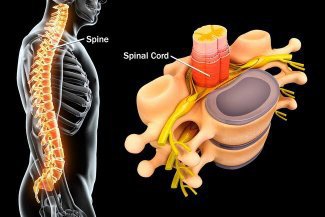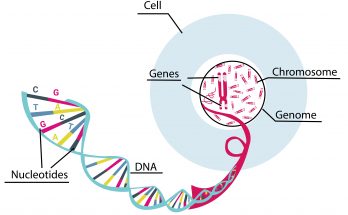The spinal cord and the backbone are two distinct structures that play critical roles in the human body. This article offers a detailed comparison of their composition, functions, and importance within the skeletal and nervous systems. Highlighting the differences and interconnections between the spinal cord and the backbone helps illustrate how they support bodily functions and provide protection.
Table of Contents
Difference between Spine and Spinal cord in Tabular Format
Here’s a table summarising the differences between the spinal cord and the backbone:
| Feature | Spinal Cord | Spine (Backbone) |
|---|---|---|
| Composition | Tube-like structure consisting of nerve fibres | Series of bones called vertebrae |
| Function | Pathway for communication between the brain and the body | Provides structural support and protects the spinal cord |
| Segments | Divided into 31 segments: 8 cervical, 12 thoracic, 5 lumbar, 5 sacral, 1 coccygeal | Divided into 5 major sections: cervical, thoracic, lumbar, sacrum, coccyx |
| Association | Encased within the backbone, extending from the brainstem to the lower back | Houses and protects the spinal cord |
| Length | Shorter, ends in the lower back region | Longer, extends from the base of the skull to the coccyx |
| Part of System | Central nervous system, crucial for neural communication | Skeletal system, provides structural framework of the body |
Detailed Difference between Spine and Spinal cord
Composition
Spinal Cord:
The spinal cord is a cylindrical structure composed of densely packed nerve fibres. These fibres are crucial for the relay of information between the brain and the rest of the body, enabling a multitude of bodily functions. This tube-like structure extends from the brainstem down the vertebral column and is enveloped in protective membranes called meninges.
Backbone (Spine):
Also known as the spinal column, the backbone is an assembly of bones termed vertebrae. These vertebrae are interlocked to form the backbone, which acts as the main supportive framework of the body. The backbone not only facilitates upright posture and movement but also plays a pivotal role in protecting the spinal cord housed within it.
Also Check – Spine and Spinal Cord Anatomy
Function
Spinal Cord:
The spinal cord’s primary function is to facilitate communication between the brain and various body parts. This communication is vital for coordinating movement and relaying sensory information back to the brain, thereby influencing both motor and sensory functions.
Backbone (Spine):
The backbone provides critical structural support, supports the body’s weight, and serves as a protective shield for the spinal cord. It also enables flexibility and mobility, allowing for various movements without compromising the protection of the spinal cord.
Segments
Spinal Cord:
The spinal cord is organised into 31 segments, each connected to a pair of nerve roots that branch out to different parts of the body. These segments are categorised as 8 cervical, 12 thoracic, 5 lumbar, 5 sacral, and 1 coccygeal nerves, each responsible for specific body functions.
Backbone (Spine):
The backbone is segmented into five major regions: the cervical spine (neck), thoracic spine (upper back), lumbar spine (lower back), sacrum, and coccyx (tailbone). Each segment supports different bodily functions and has varying degrees of mobility and stability.
Association with Each Other
The spinal cord and backbone have a symbiotic relationship. The spinal cord is neatly encased within the vertebral canal of the backbone, extending from the brainstem to the lumbar region where it tapers into the cauda equina. The backbone not only protects the spinal cord but also ensures its connectivity with the brain, facilitating the CNS’s central role.
Length in Humans
Backbone (Spine):
The backbone is the longer structure, stretching from the base of the skull to the coccyx. It is designed to bear the body’s weight and provide structural integrity.
Spinal Cord:
The spinal cord, while shorter, plays a no less critical role. It typically terminates around the lower back area at the first or second lumbar vertebra, which is why injuries below this point do not directly impact the spinal cord.
Part of System
Backbone (Spine):
The backbone is a crucial component of the skeletal system, which is responsible for the overall structural framework and protection of various body organs alongside the spinal cord.
Spinal Cord:
As part of the central nervous system, the spinal cord is essential for processing and dispatching information to and from the brain, playing a key role in the functioning of the body.
Key Terms
- Vertebrae: The individual bones stacked to form the backbone.
- Nerve Fibres: The components of the spinal cord responsible for transmitting electrical signals throughout the body.
- Central Nervous System: The complex system comprising the brain and spinal cord, responsible for directing bodily functions.
- Skeletal System: The entire collection of bones in the body, including the backbone, which supports and protects bodily organs.
FAQs on Backbone (Spine): and Spinal cord
What is the primary function of the spinal cord?
- Answer: The primary function of the spinal cord is to transmit neural signals between the brain and the rest of the body, facilitating communication that allows for movement and sensation.
How does the backbone protect the spinal cord?
- Answer: The backbone protects the spinal cord by encasing it within the vertebral column, which is made up of multiple vertebrae that provide a hard, protective shield against physical damage.
Also Check – Nerves – What They Are and What They Do
Describe the composition of the backbone.
- Answer: The backbone, or spinal column, is composed of a series of bones called vertebrae. These bones are stacked one on top of the other and provide the main structural support for the body.
What are the segments of the spinal cord, and how are they classified?
- Answer: The spinal cord is divided into 31 segments, classified into five groups based on their location: 8 cervical nerves, 12 thoracic nerves, 5 lumbar nerves, 5 sacral nerves, and 1 coccygeal nerve.
How are the spinal cord and backbone associated with each other anatomically?
- Answer: Anatomically, the spinal cord is housed within the vertebral canal of the backbone. The backbone provides structural support and protection, allowing the spinal cord to function effectively without risk of injury.
Which system does the backbone belong to, and what is its role within this system?
- Answer: The backbone belongs to the skeletal system and plays a crucial role in providing structural support, enabling movement, and protecting vital organs, including the spinal cord.
What are the differences in length between the spinal cord and the backbone, and what does this imply?
- Answer: The spinal cord is shorter than the backbone, ending in the lower back area around the first lumbar vertebra, while the backbone extends from the base of the skull to the coccyx. This implies that the spinal cord does not extend the full length of the backbone, which provides additional protection in the lower segments of the backbone.
Explain how the spinal cord’s function impacts the human body’s ability to react to stimuli.
- Answer: The spinal cord’s role in transmitting information between the brain and the body allows for quick responses to stimuli. Nerve impulses travel along the spinal cord, enabling rapid communication that results in immediate motor responses or sensory perceptions.



